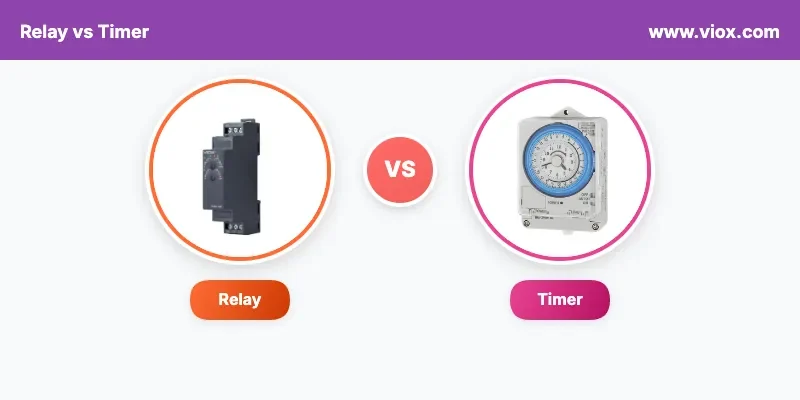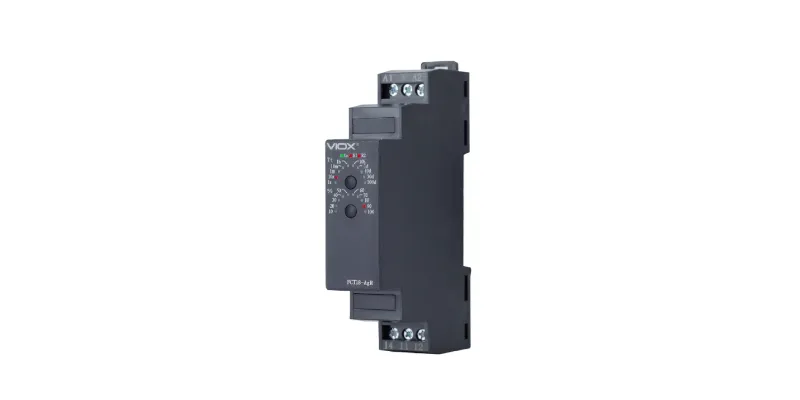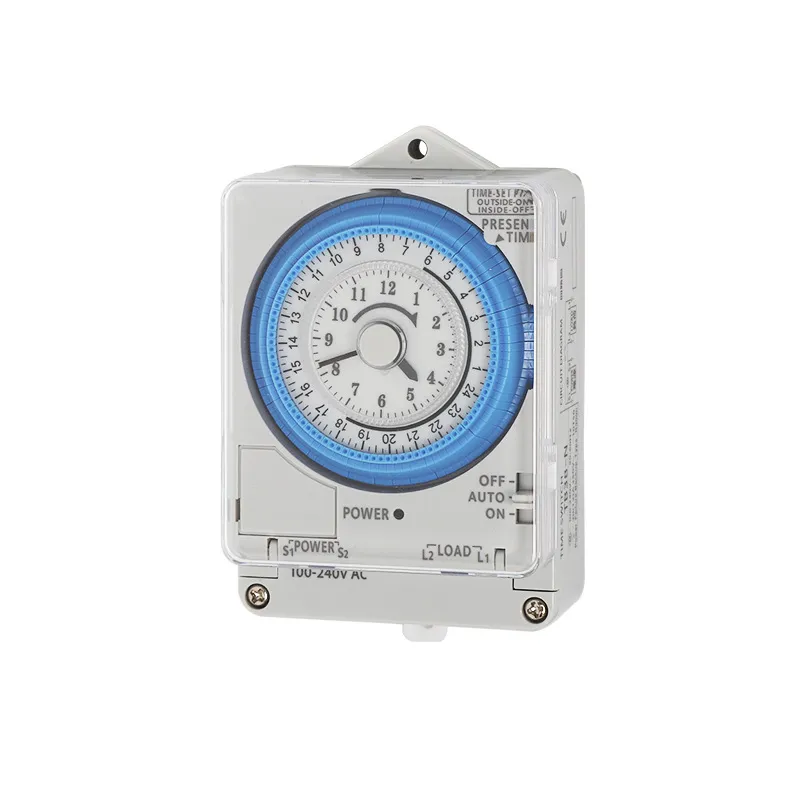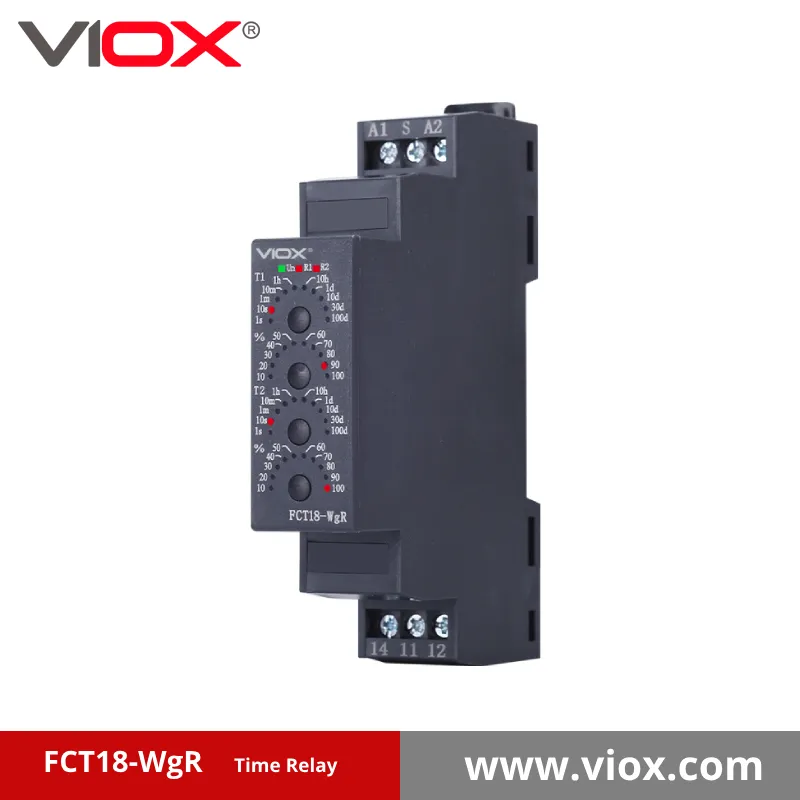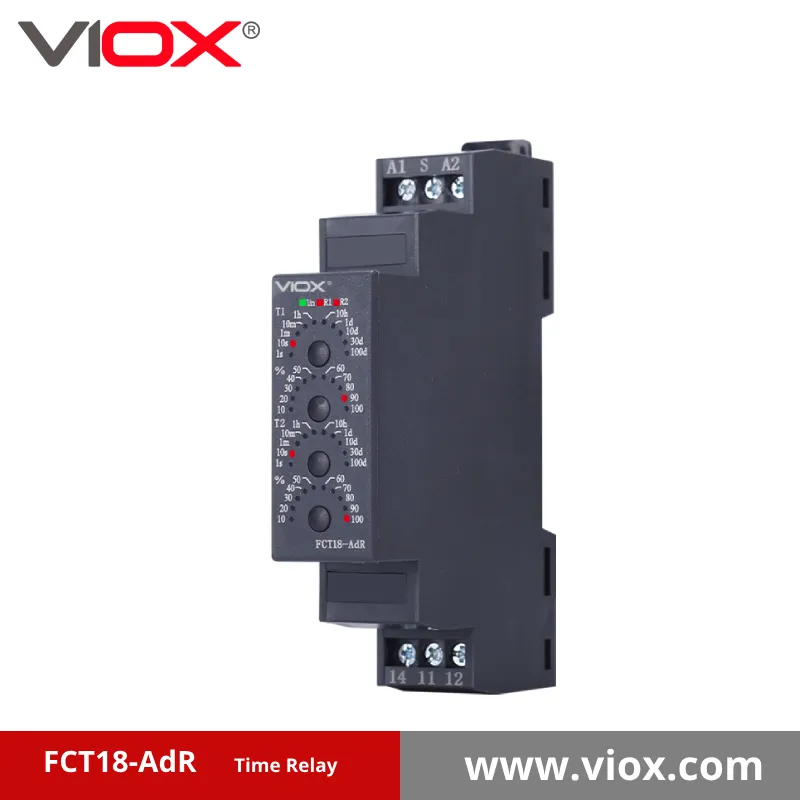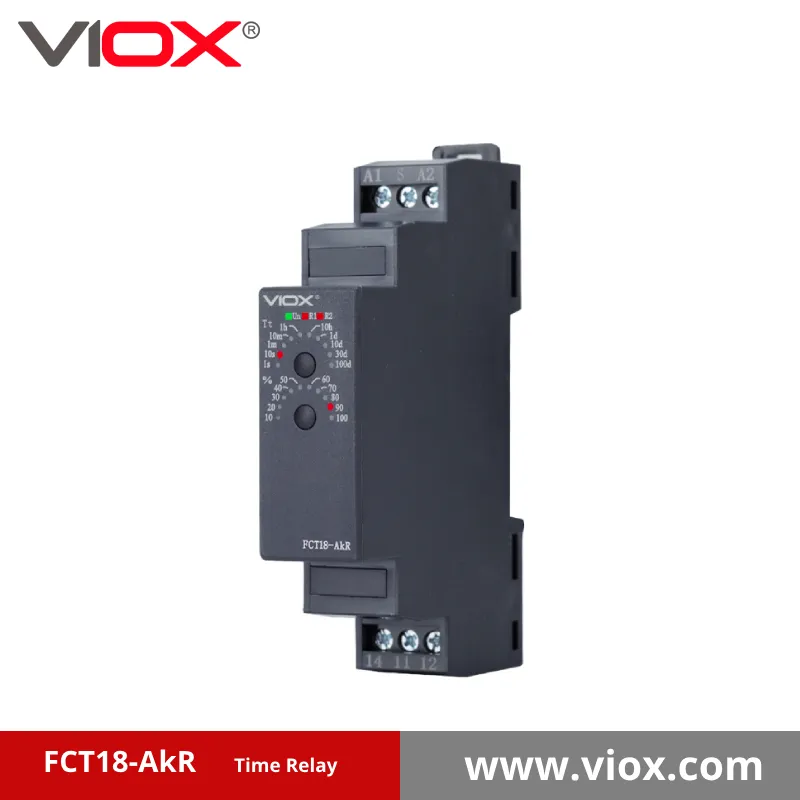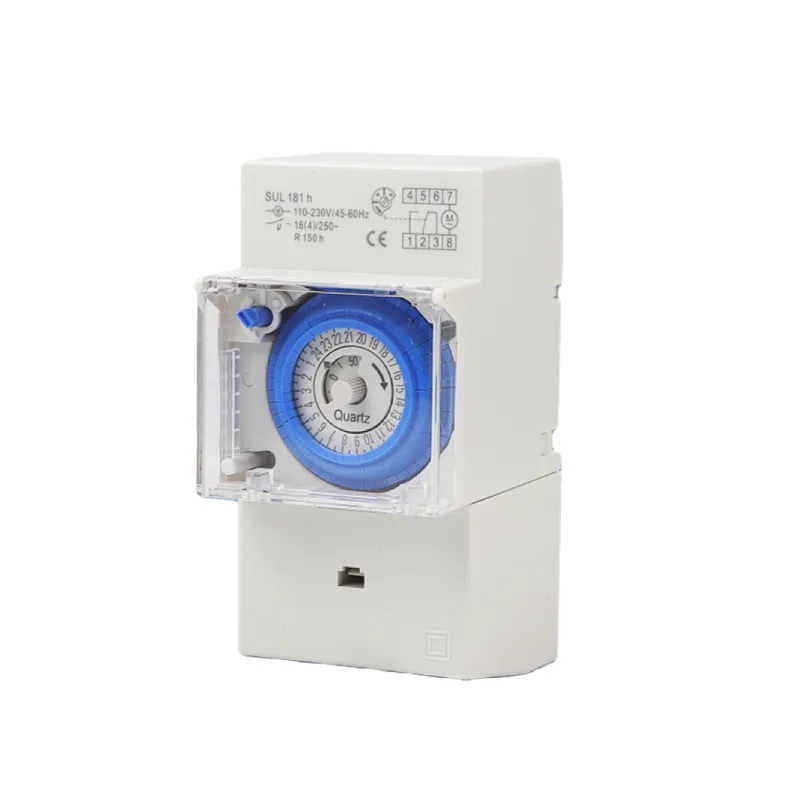A relé egy elektromosan működtetett kapcsoló, amely egy áramkört vezérel egy másik áramkör érintkezőinek nyitásával vagy zárásával, míg az időzítő egy olyan eszköz, amely előre beállított időintervallumok alapján vezérli az elektromos áramköröket. Mindkét eszköz alapvető eleme az elektromos vezérlőrendszereknek, de eltérő funkciókat látnak el, amelyek meghatározzák, hogy mikor és hogyan kell használni őket.
A relék és az időzítők közötti különbség megértése kulcsfontosságú mindazok számára, akik elektromos vezérlőrendszerekkel, automatizálási berendezésekkel vagy ipari alkalmazásokkal dolgoznak. Ez az átfogó útmutató segít a megfelelő választásban az adott alkalmazáshoz, miközben biztosítja a biztonságot és a szabványoknak való megfelelést.
Mi az a relé?
A relé egy elektromágneses kapcsoló amely kis elektromos áramot használ egy sokkal nagyobb áram szabályozására egy különálló áramkörben. Amikor a relétekercs áramot kap, mágneses mezőt hoz létre, amely fizikailag mozgatja a fém érintkezőket, hogy vagy nyissa, vagy zárja az elektromos csatlakozásokat.
Főbb relé jellemzők:
- Azonnali működés amikor a tápellátás rá van kapcsolva vagy le van választva
- Elektromos szigetelés a vezérlő és a kapcsolt áramkörök között
- Többszörös érintkezőkonfigurációk (alaphelyzetben nyitott, alaphelyzetben zárt, váltó)
- Áramerősítés képesség (kis vezérlőáram nagy terhelési áramot kapcsol)
- Nincs időzítő funkció beépítve az alapvető relékbe
Mi az az időzítő?
A időzítő egy időrelé amely az előre beállított időintervallumok alapján vezérli az elektromos áramkörök be- és kikapcsolását. Az időzítők késleltethetik a berendezések aktiválását, szabályozhatják az eszközök működési idejét, vagy létrehozhatnak meghatározott időzítési sorozatokat automatizált rendszerekben.
Főbb időzítő jellemzők:
- Időalapú vezérlés állítható késleltetési időkkel
- Különböző időzítési funkciók (bekapcsolási késleltetés, kikapcsolási késleltetés, intervallum, ismétlési ciklus)
- Digitális vagy analóg időbeállítás mechanizmusok
- Beépített időzítő áramkörök elektronikus vagy mechanikus módszerekkel
- Programozható időzítési szekvenciák fejlett modellekben
Relé vs. időzítő: Átfogó összehasonlítás
| Jellemző | Relé | Időzítő |
|---|---|---|
| Elsődleges funkció | Elektromos kapcsolás | Időalapú vezérlés |
| Működési sebesség | Azonnali (milliszekundum) | Késleltetett (másodperctől órákig) |
| Szabályozási módszer | Feszültség megléte/hiánya | Előre beállított időintervallumok |
| Áramkör elszigetelése | Igen, teljes elszigeteltség | Kialakítás szerint változik |
| Időzítési képesség | Nincs (alap relék) | Alapvető funkciók |
| Energiafogyasztás | Alacsony aktiváláskor | Folyamatos az időzítés alatt |
| Komplexitás | Egyszerű elektromágneses eszköz | Komplex időzítő áramkörök |
| Költségek Tartomány | $5-50 (alapmodellek) | $25-500+ (a funkcióktól függően) |
| Tipikus alkalmazások | Motorvezérlés, világításkapcsolás | Késleltető áramkörök, automatizálási szekvenciák |
| Telepítés bonyolultsága | Egyszerű bekötés | Programozást igényelhet |
Alkalmazások és felhasználási esetek
Mikor használjunk reléket?
A relék ideálisak olyan alkalmazásokhoz, amelyek a következőket igénylik:
- Motorindítás és leállítás
- Nagy motorok vezérlése kis vezérlőkapcsolókkal
- Vezérlőáramkörök védelme a nagy motoráramoktól
- Távoli motorműködtetés engedélyezése
- Világításvezérlő rendszerek
- Nagy teljesítményű világítás kapcsolása alacsony feszültségű vezérlőkről
- Világítási zónák létrehozása kereskedelmi épületekben
- Csatlakozás épületautomatizálási rendszerekhez
- Biztonsági reteszek
- Vészleállító áramkörök
- Ajtóreteszelő rendszerek
- Gépbiztonsági vezérlők
- Jelerősítés
- Alacsony áramerősségű érzékelőjelek átalakítása nagy teljesítményű terhelések kapcsolására
- Különböző feszültségrendszerek közötti interfész
- Több kimenet létrehozása egyetlen bemenetből
Mikor használjunk időzítőket
Az időzítők elengedhetetlenek az olyan alkalmazásokhoz, amelyek a következőket igénylik:
- Késleltetett berendezésindítás
- HVAC rendszer fokozatos bekapcsolás az egyidejű indítás megakadályozása érdekében
- Szivattyúvezérlés vízrendszerekben
- Világítás késleltető áramkörök
- Automatikus berendezésleállítás
- Ventilátor-utánfutási időzítők a fűtési rendszerek kikapcsolása után
- Szivattyú kifutási időzítők a maradék folyadékhoz
- Biztonsági berendezések időtúllépési funkciói
- Folyamatszabályozási szekvenciák
- Gyártóberendezések időzítése
- Kémiai keverési folyamatok
- Automatizált összeszerelő sor vezérlés
- Energiagazdálkodás
- Ütemezett berendezésüzemeltetés
- Csúcskereslet-csökkentés
- Automatikus világításvezérlés
Relék és időzítők típusai
Relé kategóriák
| Típus | Leírás | Tipikus alkalmazások |
|---|---|---|
| Általános rendeltetésű | Alapvető SPDT/DPDT kapcsolatok | Világítás, kismotorok |
| Teljesítményrelék | Nagy áramerősség | Nagy motorok, fűtőberendezések |
| Biztonsági relék | Kényszervezérelt érintkezők | Vészleállító rendszerek |
| Szilárdtest | Nincsenek mozgó alkatrészek | Gyakori váltási alkalmazások |
| Reteszelés | Teljesítmény nélkül tartja meg a pozícióját | Energiatakarékos alkalmazások |
Időzítő kategóriák
| Típus | Leírás | Időzítési tartomány |
|---|---|---|
| Bekapcsolás-késleltetés | Késlelteti a bekapcsolást a trigger után | 0,1 mp – 24 óra |
| Kikapcsolási késleltetés | Késlelteti a kikapcsolás a ravasz eltávolítása után | 0,1 mp – 24 óra |
| Intervallum | Bekapcsol a beállított időtartamra, majd kikapcsol | 0,1 mp – 999 óra |
| Ismételje meg a ciklust | Folyamatos be-/kikapcsolás | Változó ciklusok |
| Többfunkciós | Programozható időzítési módok | Nagyon változó |
Kiválasztási kritériumok és szakértői tippek
A megfelelő relé kiválasztása
Főbb szempontok:
- Kapcsolat konfiguráció
- Határozza meg, hogy hány áramkört kell vezérelnie
- Vegye figyelembe a normál esetben nyitott és a normál esetben zárt követelményeket
- Figyelembe a jövőbeli bővítési igények
- Áramerősség- és feszültségértékek
- Méretezze az érintkezőket a tényleges terhelési áramhoz plusz 25% biztonsági ráhagyás
- Ellenőrizze, hogy a tekercs feszültsége megegyezik-e a vezérlő áramkörrel
- Vegye figyelembe a bekapcsolási áramot motorterhelés esetén
- Környezeti követelmények
- Válassza ki a megfelelő zártsági fokozatot (NEMA 1, 4, 7, stb.)
- Vegye figyelembe a szélsőséges hőmérsékleti és páratartalom értékeket
- Figyelembe kell venni az ipari alkalmazásokban fellépő rezgéseket
💡 Szakértői tipp: 1 LE-nél nagyobb motorok esetén mindig kontaktorokat használjon általános célú relék helyett a megfelelő ívkisülés-elnyomás és az érintkező élettartamának biztosítása érdekében.
A megfelelő időzítő kiválasztása
Kritikus kiválasztási paraméterek:
- Szükséges időzítési funkció
- Határozza meg, hogy bekapcsolási késleltetésre, kikapcsolási késleltetésre vagy intervallumos időzítésre van-e szüksége
- Vegye figyelembe a többfunkciós időzítőket összetett sorozatokhoz
- Értékelje a kézi felülbírálási lehetőségek szükségességét
- Időtartomány-követelmények
- Válasszon időzítőt a megfelelő minimális és maximális időbeállításokkal
- Vegye figyelembe a jövőbeni időzítési módosításokat
- Gondolja át, hogy digitális vagy analóg beállítást részesít-e előnyben
- Tápegység-kompatibilitás
- Ellenőrizze, hogy az időzítő a rendelkezésre álló vezérlőfeszültségen működik-e
- Vegye figyelembe az energiafogyasztást az időzítési időszakok alatt
- Vegye figyelembe a tartalék áramellátási követelményeket, ha alkalmazható
💡 Szakértői tipp: Gyakori időzítési beállításokat vagy nagy pontosságot igénylő alkalmazásokban elektronikus időzítőket használjon a mechanikusak helyett.
Biztonsági szempontok és a szabályzatnak való megfelelés
Elektromos biztonsági követelmények
⚠️ Fontos biztonsági figyelmeztetés: Mindig kövesse NEC (Országos Villamos Szabályzat) relék és időzítők telepítésekor betartandó követelmények. A nem megfelelő telepítés a berendezés károsodását, tüzet vagy személyi sérülést okozhat.
Alapvető biztonsági gyakorlatok:
- Használjon megfelelően méretezett túláramvédelmet minden áramkörhöz
- Biztosítsa a csatlakoztatott terheléseknek megfelelő vezetékméretet
- Biztosítson megfelelő földelést az NEC 250. cikkelye szerint
- Szereljen fel ívzárlatvédelmet, ahol a helyi előírások előírják
Szakmai telepítési követelmények
Mikor érdemes minősített villanyszerelőket igénybe venni:
- Bármilyen 50 V-nál nagyobb feszültséget magában foglaló telepítés
- Kereskedelmi vagy ipari alkalmazások
- Integráció tűzvédelmi vagy biztonsági rendszerekkel
- Meglévő elektromos panelek átalakítása
Gyakori problémák elhárítása
Reléproblémák és megoldások
| Probléma | Lehetséges ok | Megoldás |
|---|---|---|
| A relé nem kap áramot | Nincs tekercsfeszültség | Ellenőrizze a vezérlőáramkör vezetékezését |
| Érintkezők összehegesztve | Túlzott bekapcsolási áram | Szereljen fel áramkorlátozót vagy használjon kontaktort |
| A tekercs kiég | Túlfeszültségi állapot | Ellenőrizze a tápfeszültség névleges értékeit |
| Szabálytalan működés | Rossz kapcsolatok | Tisztítsa meg és húzza meg az összes csatlakozót |
Időzítő problémák és megoldások
| Probléma | Lehetséges ok | Megoldás |
|---|---|---|
| Pontatlan időzítés | Hőmérsékleti hatások | Használjon hőmérséklet-kompenzált időzítőt |
| Az időzítő nem indul el | A bemeneti jel túl rövid | Ellenőrizze a minimális impulzusszélességre vonatkozó követelményeket |
| Az időzítés időbeli eltolódása | Alkatrész öregedés | Kalibrálja vagy cserélje ki az időzítőt |
| A kijelző nem működik | Tápellátási problémák | Ellenőrizze a megfelelő tápfeszültséget |
Költségelemzés és megtérülési szempontok
Kezdeti befektetés összehasonlítása
Alapvető relérendszerek:
- Egyszerű relé: $10-25
- Telepítési munkadíj: $50-100
- Teljes projektköltség: $60-125
Alapvető időzítő rendszerek:
- Elektronikus időzítő: $50-150
- Telepítés és programozás: $100-200
- Teljes projektköltség: $150-350
Hosszú távú értékbecslés
A relé előnyei:
- Alacsonyabb kezdeti költség
- Minimális karbantartási követelmények
- Hosszú élettartam (átlagosan 10+ év)
- Egyszerű csereeljárások
Az időzítő előnyei:
- Energiamegtakarítás optimalizált vezérléssel
- Csökkentett kézi működtetési igény
- Javított folyamatkonzisztencia
- Továbbfejlesztett rendszerautomatizálási képességek
A telepítés legjobb gyakorlatai
Relé telepítési útmutató
- Szerelési irány
- Az optimális érintkezőteljesítmény érdekében lehetőség szerint függőlegesen szerelje fel a reléket
- Kerülje a fejjel lefelé történő szerelést az érintkezőhegedés elkerülése érdekében.
- Biztosítsa a megfelelő szellőzést a relé burkolata körül
- Vezetékezési gyakorlatok
- Használjon megfelelő vezetékvastagságot a csatlakoztatott terhelésekhez
- Induktív terhelések túlfeszültség-elnyomásának megvalósítása
- Címkézze fel az összes vezetéket a jövőbeni karbantartás érdekében
- Vizsgálati eljárások
- Telepítés előtt ellenőrizze a tekercs ellenállását
- Érintkező működésének tesztelése multiméterrel
- Ellenőrizze a megfelelő érintkezőnyílást és -zárást
Időzítő telepítési útmutató
- Tápellátási követelmények
- Ellenőrizze a megfelelő feszültséget és frekvenciát
- Biztosítson stabil áramforrást a pontos időzítéshez
- Fontolja meg az UPS biztonsági mentését kritikus alkalmazásokhoz
- Programozás és beállítás
- Dokumentálja az összes időzítési beállítást későbbi felhasználás céljából
- Üzembe helyezéskor ellenőrizze az időzítés pontosságát stopperórával
- Írásos kezelési utasításokat kell biztosítani a felhasználók számára
- Környezetvédelem
- Használjon megfelelő NEMA-besorolású burkolatokat
- Védje az elektromágneses interferenciától
- Biztosítsa a megfelelő hőmérséklet-szabályozást a tárolóhelyeken
Gyakran Ismételt Kérdések
K: Tud egy relé időzítési funkciókat ellátni?
V: Az alapvető relék nem tudnak időzítő funkciókat ellátni. Az időrelé relék azonban beépített időzítő áramkörökkel kombinálják a reléérintkezőket, így egyetlen eszközben kínálnak kapcsolási és időzítési funkciókat is.
K: Mi a különbség a mechanikus és az elektronikus időzítők között?
V: A mechanikus időzítők óraszerkezetet használnak, és kevésbé pontosak, de jobban ellenállnak az elektromos interferenciának. Az elektronikus időzítők nagyobb pontosságot, több funkciót és programozható funkciókat kínálnak, de a teljesítményminőségi problémák befolyásolhatják őket.
K: Honnan tudhatom, hogy relére vagy időzítőre van-e szükségem az alkalmazásomhoz?
V: Ha bemeneti jel alapján azonnali kapcsolás szükséges, használjon relét. Ha időintervallumok alapján kell szabályoznia, hogy mikor történik valami, használjon időzítőt. Mindkét funkcióhoz érdemes időrelé-relét vagy programozható vezérlőmodult használni.
K: Milyen biztonsági tanúsítványokat kell keresnem?
V: Észak-Amerikában keresse az UL (Underwriters Laboratories) listát, Európában a CE jelölést, és ahol alkalmazható, a CSA (Canadian Standards Association) jóváhagyást. Az ipari alkalmazások további tanúsítványokat igényelhetnek, például robbanásbiztos besorolást.
K: Használhatók időzítők és relék együtt ugyanabban a rendszerben?
V: Igen, az időzítőket és a reléket gyakran használják együtt összetett vezérlőrendszerekben. Az időzítők biztosítják az időzítési logikát, míg a relék a terhelések tényleges kapcsolását kezelik, kifinomult automatizálási szekvenciákat hozva létre.
K: Milyen karbantartást igényelnek a relék és az időzítők?
V: A relék általában rendszeres érintkezőtisztítást és -cserét igényelnek hosszabb használat után. Az elektronikus időzítők minimális karbantartást igényelnek, de az időzítés pontosságát évente ellenőrizni kell. Mindkettőt ellenőrizni kell a biztonságos csatlakozások és a megfelelő rögzítés szempontjából.
K: Hogyan méretezek egy relét motorindító alkalmazásokhoz?
A: Motorindításhoz olyan reléérintkezőket válasszon, amelyek legalább a motor teljes terhelési áramának hatszorosára vannak méretezve, hogy kezeljék az indítási bekapcsolási túláramot. Még jobb, ha kifejezetten erre az alkalmazásra tervezett, megfelelő túlterhelésvédelemmel ellátott motorindító kontaktort használ.
K: Mennyi a relék és az időzítők átlagos élettartama?
V: A minőségi relék megfelelő telepítés és megfelelő terhelésméretezés esetén 10-15 évig működhetnek. Az elektronikus időzítők jellemzően 15-20 évig tartanak, míg a mechanikus időzítőket a használat gyakoriságától függően 8-12 évente cserélni kell.
A helyes választás: Döntési keretrendszer
Használjon relét, amikor:
- Azonnali váltási reakcióra van szükséged
- A vezérlő- és terhelési áramkörök leválasztást igényelnek
- Az egyszerű be-/kikapcsolás elegendő
- A költség elsődleges szempont
- Nagy áramkapcsolási képességre van szükség
Használjon időzítőt, amikor:
- Időalapú vezérlés szükséges
- Automatizált szekvenciákra van szükség
- Az energiagazdálkodás fontos
- A folyamatoptimalizálás a cél
- A berendezésvédelem időzítést igényel
Vegye figyelembe a kombinált megoldásokat, ha:
- Komplex vezérlési szekvenciákra van szükség
- Azonnali és időzített válaszokra egyaránt szükség van
- A jövőbeni rendszerbővítés várható
- Az épületautomatizálási rendszerekkel való integráció tervben van
Szakértői javaslatok, valamint a Következő Lépések
Az optimális eredmény érdekében:
- Konzultáljon szakképzett villanyszerelőkkel nagyfeszültségű vagy összetett rendszereket tartalmazó telepítésekhez
- Tekintse át a helyi elektromos előírásokat mielőtt bármilyen telepítést megkezdenénk
- Dokumentálja az összes beállítást és konfigurációt a jövőbeni karbantartáshoz
- Jövőbeli bővítés terve nagyobb kapacitású eszközök kiválasztásával
- Megfelelő címkézés alkalmazása minden vezérlőberendezéshez és áramkörhöz
Szakmai konzultáció ajánlott a következők esetén:
- Ipari automatizálási rendszerek
- Életvédelmi alkalmazások
- Integráció a meglévő épületfelügyeleti rendszerekkel
- Nagyfeszültségű vagy nagyáramú alkalmazások
- Speciális iparági tanúsítványokat igénylő alkalmazások
A relék és az időzítők közötti alapvető különbségek megértése lehetővé teszi hatékonyabb vezérlőrendszerek tervezését, miközben garantálja a biztonságot és az előírásoknak való megfelelést. Akár egyszerű világítási áramköröket, akár összetett ipari folyamatokat vezérel, a megbízható és hatékony működéshez elengedhetetlen a megfelelő eszköz kiválasztása minden egyes alkalmazáshoz.
Az azonnali kapcsolást és időalapú vezérlést egyaránt igénylő összetett alkalmazások esetén érdemes automatizálási szakemberekkel konzultálni, akik integrált megoldásokat tudnak tervezni programozható logikai vezérlők (PLC-k) vagy más fejlett vezérlőrendszerek használatával, amelyek a relék és az időzítők előnyeit ötvözik kifinomult vezérlőarchitektúrákban.

